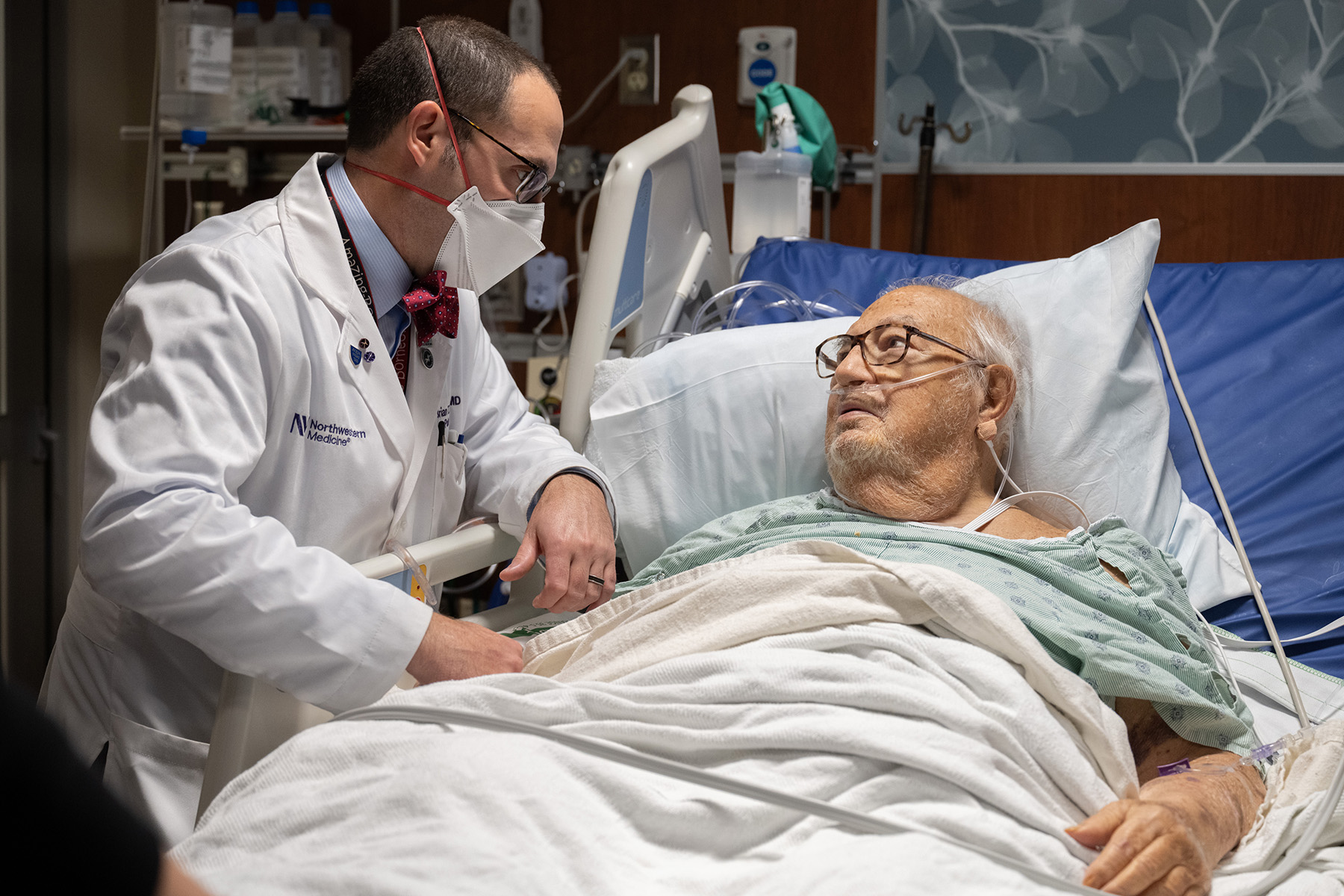Northwestern Medicine investigators have continued to examine COVID-19, from the impact of prone positioning during treatment to vaccine protection against the Omicron variant in children.
Omicron: fewer adverse outcomes, but also new dangers

The decreased individual risk of hospitalization and death from the Omicron variant of COVID-19 compared to earlier variants is reassuring, but the increased transmission still poses a danger to the health system, according to a commentary published in The Lancet.
“One of the more evident dangers of Omicron is its capacity to transmit so efficiently that can reach a significant portion of the population, therefore it can reach high-risk populations easier,” said Ramon Lorenzo-Redondo, PhD, assistant professor of Medicine in the Division of Infectious Diseases and senior author of the commentary. “In fact, USA has seen its highest peak of hospitalizations during the Omicron expansion despite its lower inherent severity.”
The winter Omicron wave is over in the USA, yet new viral lineages such as the Omicron sub-variant BA.2 pose a renewed threat. While mRNA vaccines still provide a significant protection against hospitalization and death, many low-income countries have little access to the expensive and finicky mRNA vaccines, and new variants will continue to mutate from original COVID-19 to in order to escape from vaccine or naturally acquired immunity, according to Lori Post, PhD, the Buehler Professor of Geriatric Medicine, director of the Buehler Center for Health Policy and Economics at the Institute for Public Health and Medicine (IPHAM) and senior author of the commentary. This may lead to a vicious cycle, she said.
“Fortunately, the adverse outcomes are down with Omicron,” Post said.
“Unfortunately, so many people are catching it that it will lead to new variants of concern, and many low-income countries have not been vaccinated which will allow the proliferation of new variants that might be more transmissible and could lead to increased severity regionally due to the lack of vaccine-elicited immunity and subsequent global expansions of these new variants.”
Prone Positioning and COVID-19

Interventions to increase prone positioning of patients with COVID-19 experiencing low blood oxygen levels did not improve outcomes, according to a study published in the journal BMJ.
Patient adherence to prone positioning was poor and contributed to the trial stopping early, according to Melissa Bregger, MD, assistant professor of Medicine in the Division of Hospital Medicine and a co-author of the study.
“Simply instructing a patient to lay on their stomach as much as possible was not useful,” Bregger said.
Prone positioning has been part of clinical practice since the 1970s and is considered standard of care for mechanically ventilated patients who have severe acute respiratory distress syndrome. Several observational studies have examined the effectiveness of prone positioning in non-intubated patients with COVID-19, finding mixed results.
The current study enrolled nearly 250 patients across 15 hospitals in the U.S. and Canada, measuring a primary outcome of in-hospital death, mechanical ventilation or worsening respiratory failure. Patients randomized to prone positioning were recommended to adopt a prone position four times a day (up to two hours for each session) and encouraged to sleep in prone position overnight.
At the time the trial was stopped, investigators did not observe improvements in the risk of death or mechanical ventilation, and likewise did not see improvements in oxygenation.
Importantly, the overall time spent prone per day was lower than planned, part of the difficulty of keeping patients in prone position, Bregger said.
“One major take-away is how challenging it is to get patients to adhere to prone positioning,” Bregger said. “Future studies are needed examining interventions that improve adherence to prone positioning,”
This study was funded by St Michael’s Hospital Innovation Fund, the Sinai Health Research Fund, and Sunnybrook Health Sciences Centre Alternate Funding Plan Innovation Fund.
Pfizer Protection against Omicron in Children

The Pfizer-BioNTech mRNA vaccine provided strong protection against hospitalization for COVID-19 during the period for which the Delta variant was dominant, according to a study published in the New England Journal of Medicine.
Protection against hospitalization was slightly lower during the period for which the Omicron variant was dominant, but still reduced the risk of omicron-associated hospitalization by two-thirds among children 5 to 11 years of age.
“The takeaway from this study is that vaccination protects against life-threatening SARS-CoV-2 infection in children,” said Bria Coates, MD, ’08, ’11 GME, assistant professor of Pediatrics in the Division of Critical Care and co-author of the study. “We should continue to encourage vaccination in children and support easy access to vaccination for all our patients.”
Investigators enrolled patients with and without COVID-19 at 31 hospitals across the U.S., nearly 3,000 patients in total. 25 percent of the patients with COVID-19 had severe illness.
Vaccine effectiveness for avoiding hospitalization during the Delta and Omicron periods combined was about 80 percent for children older than 11. However, the Pfizer-BioNTech mRNA vaccine was significantly less protective for Omicron compared to the Delta variants: 92 percent effective versus just 40 percent effective.
Acute Upper Airway Infection in Children with Omicron

The Omicron variant of SARS-CoV-2 caused greater rates of upper airway infection in children compared to other variants, according to a study published in JAMA Pediatrics.
Clinicians should be aware of this greater rate of upper airway infection (UAI), according to L. Nelson Sanchez-Pinto, MD, assistant professor of Pediatrics in the Division of Critical Care and a co-author of the study.
“Omicron overall caused a milder disease in most people, but the high number of infected children resulted in a sizeable number of UAI cases — with its associated increase risk for severe disease — even if these represented a small fraction of all the infected children,” said Sanchez-Pinto, who is also a professor of Preventive Medicine in the Division of Health and Biomedical Informatics.
The study used the National COVID Cohort Collaborative (N3C) to examine children younger than 19 years old with a positive test result and UAI diagnosis. SARS-CoV-2–positive UAI rates increased from the pre-Omicron to Omicron periods, from 1.5 percent to 4.1 percent, respectively.
This may be caused by the differential replication pattern observed in Omicron compared to earlier variants — Omicron replicates more effectively in the airway and less effectively in the lungs compared to Delta, according to the study.
New patterns of illness may emerge with new variants, and finding such as these can help put clinicians on the lookout, Sanchez-Pinto said.
“Even if the overall percentage of kids affected by severe disease is small, the absolute numbers of the most severely affected will be a directly correlated with the absolute number of cases overall, and we know some variants of COVID can be incredibly transmissible and contagious,” Sanchez-Pinto said.
This study was funded by the Eunice Kennedy Shriver National Institute of Child Health and Human Development (R01HD105939-01S1).






